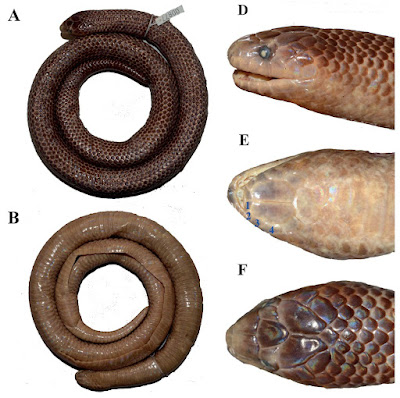 |
| Atractus paulus Melo-Sampaio & Venegas, 2023 |
Abstract
Based on an exhaustive revision of external morphological characters we describe a new species of Atractus from the humid montane forest of the Andes of northern Peru, Cajamarca department, occurring at elevations of 1641 to 2161 m. This new species was misidentified as A. gigas in the literature and for more than a decade represented the southernmost record of the that species. In the absence of molecular data and limited by a small sample, we use some underreported characters in the genus Atractus such as the presence of apical pits. Thus, the combination of apical pits as well as other characters mentioned in the literature (i.e., head scutellation and number of subcaudals) distinguishes the Peruvian population from A. gigas, and strongly supports the morphological separation of this taxon from the rest of its congeners.
Key Words: Apical pits, Andes, endemism, morphology, scales, tubercles
Atractus paulus sp. nov.
Diagnosis: Atractus paulus can be distinguished from all congeners by the following combination of characters: (1) smooth dorsal scale rows 17/17/17 with apical pits near cloaca; (2) postoculars two; (3) loreal moderately long, contacting second to fourth supralabials; (4) temporal formula usually 1+2; (5) supralabials eight, fourth and fifth contacting eye; (6) infralabials eight, first four contacting chinshields; (7) maxillary teeth eight; (8) gular scale rows usually four; (9) preventrals four; (10) ventrals 166–167 in females, condition in males unknown; (11) subcaudals 26 in females, condition in males unknown; (12) in preservative, dorsum yellow ochre; (13) ventral surface of body mostly black with scattered inconspicuous cream marks in juveniles, uniform brown in adults; (14) maximum body size 830 mm SVL in females; (15) tail size moderately short in females (9.1–13.6% SVL); (16) midbody diameter 18.0–27.3 mm (Figs 1–3).
Etymology: The species epithet “paulus” is a Latin word being patronym for our friend Paulo Gustavo Homem Passos. Dr. Paulo Passos has described more than 34 Atractus species, approximately one-fifth of the astonishing diversity of this complex genus. The Latin word “Paulus” also means “small” and thus, we also refer to the type series composed only by the holotype and paratype.
Paulo R. Melo-Sampaio and Pablo J. Venegas. 2023. A New Species of Groundsnake Genus Atractus Wagler, 1828 (Serpentes, Dipsadidae) from the Peruvian Andes revealed by unequivocal morphological characters. Evolutionary Systematics. 7(2): 257-266. DOI: 10.3897/evolsyst.7.102578

